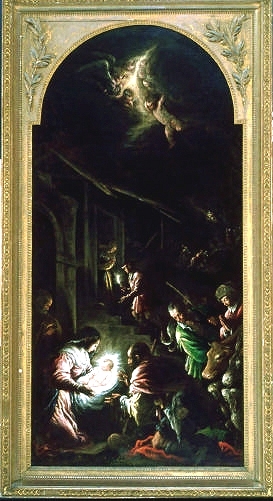Francesco Bassano
Italian 1549-1592ADORATION OF THE SHEPHERDS
SN 88 Oil on Canvas
From "The Pages"
ARTIST:
Francesco da Ponte was called Francesco Bassano the Younger. [His grandfather, Francesco
Bassano the Elder, was an artist in his native Bassano.] Francesco was the eldest of
Jacopo Bassano’s four painter sons, and was trained in his father’s workshop in
Bassano between 1560-1570. [ His father was one of the leading Venetian artists of the
16th century.] Francesco’s precocious talent was evident in 1566-1570 with the work
“Miracle of the Quails”.
During the 1570s he worked with his father on large altarpieces. At this time, he devoted
himself to rustic biblical paintings. Characteristic of these paintings are color
sprinkled with light ,and his tendency toward more descriptive realism.
In 1579, he moved from Bassano to Venice. During the next years, he painted nocturnal
scenes illuminated by candle, torch and flare, by moonlight and divine light - nativities,
adorations of the shepherds, and passion scenes, culminating in the altarpiece for Sant
Afra in Brescia. He competed with Tintoretto, Veronese and Palma Giovane and was awarded
several commissions in the Sala del Scrutinio and the Sala del Maggiore Consiglio of the
Doge’s Palace.
At the height of his success, a mental illness became more acute and he threw himself from
an upper story window. He died several months later secondary to injuries from the fall. |
|
 |
SUBJECT:
The painting illustrates the text in Luke (2:15-16). “When the angels went away from
them into heaven, the shepherds said to one another, ‘Let us go over to Bethlehem and
see this thing that has happened, which the Lord has made known to us.’ And they went
with haste, and found Mary and Joseph, and the babe lying in a manger.”
PAINTING:
The arched top and the narrow format indicate that this painting occupied a specific
architectural location.
It is a vertical night scene, with the Christ child cradled at the left foreground. A
bright, luminous light emanates from the Baby, illuminating Mary and Joseph who are
kneeling beside Him. The shepherds standing, worshipful, on the right are highlighted by
the same glow, as are the animals in the right foreground. The angels at the top of the
painting are also lit, but not as brightly.
The color is dark, but shading is present. None of the people are looking out at the
viewer, but are realistically concerned with the Child in front of them. The handling of
the foreground group is similar to Francesco’s father’s work.
The painting’s present label states, “Francesco set the adoration at night time
not only to signify the holiness of the Christ Child by the dramatic emanation of light
from the cradle, but also in order to demonstrate his own skill as a painter.” Two
followers of Francesco painted similar pieces.
HISTORIC CONTEXT:
Venice, the “Pearl of the Adriatic,” is a cluster of islands at the head of the
Adriatic Sea that was approachable only by water until the middle of the nineteenth
century, when a causeway was constructed. In the 15th century Venice expanded her
territory into the mainland; these lands were called Terrafirma, and included the town of
Bassano - a source of food supply for Venice. By the end of the 15th century, trading
activities and immigration to Venice had produced one of the most heterogeneous
populations in Europe.
Four significant circumstances made an impact upon the evolution of Venice: its singular
setting, its tenacious Byzantine heritage, success as a vast trading empire, and its
cohesive political and social structure that was cosmopolitan in character.
During the period of Counter Reformation in the 1500’s, the Council of Trent began,
the Inquisition was established, Ignatius Loyola founded the Jesuit order, Michelangelo
took over the rebuilding of Saint Peters, and Phillip II was the king of Spain and ruler
of Netherlands, Americas, Milan, Burgundy, Naples, and Sicily.
ringlingdocents.org
|